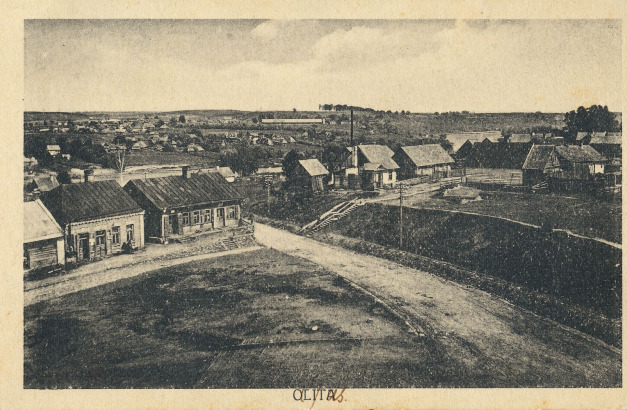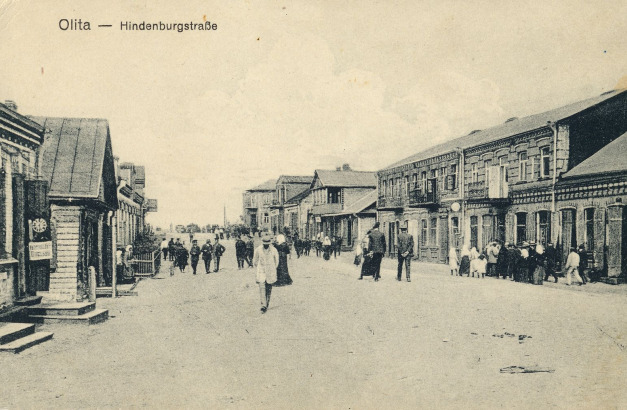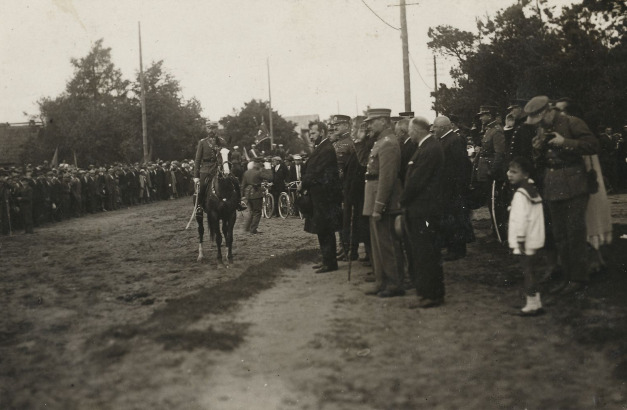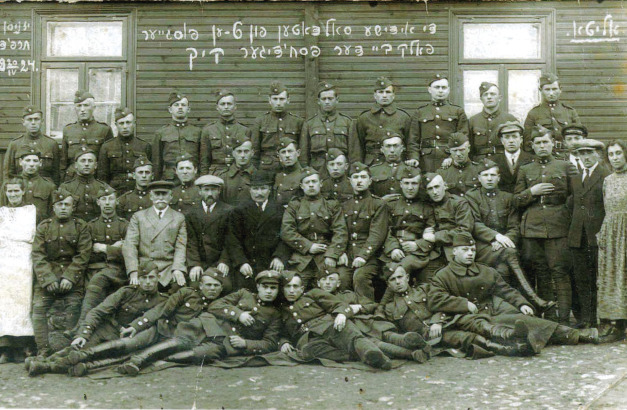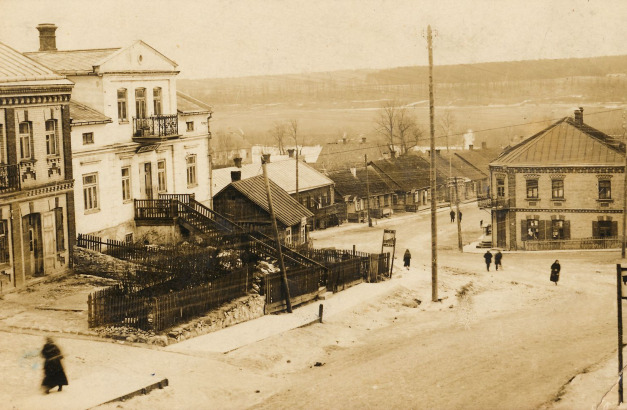Alytaus pavadinimas istoriniuose šaltiniuose minimas dar XIV a. antrojoje pusėje. Miestas kūrėsi strategiškai svarbioje vietoje – šalia Nemuno upės ir svarbių sausumos kelių sankirtos, vedusių į Vilnių, Kauną, Gardiną ir didžiuosius Lenkijos karalystės miestus. XV a. čia pradėjo formuotis dvi atskiros gyvenvietės: dešiniajame krante – Alytus I, o kairiajame - Alytus II. Dešiniajame Nemuno krante esantis Alytus I iki pat XIX a. buvo svarbus prekybos centras, kuriam 1581 m. buvo suteiktos Magdeburgo savivaldos teisės, tuo tarpu kairiajame Nemuno krante esantis miestas didesnę reikšmę įgavo tik XIX a.
Gausesnis žydų bendruomenės kūrimasis Alytuje prasidėjo XVIII a. Po trečiojo Abiejų Tautų Respublikos padalijimo (1795 m.), abi miesto dalys tapo skirtingais administraciniais vienetais, priklausančiais atskiroms valstybėms - Prūsijai ir Rusijos imperijai, vėliau atskiroms Rusijos gubernijoms. Tai lėmė ir skirtingą abiejų miesto dalių raidą. 1897 m. Rusijos gyventojų surašymo duomenimis I Alytuje gyveno 1435 gyventojai, iš jų 481 žydas, II Alytuje – 2010 gyventojai, iš jų 753 žydai. Taip mieste susidarė dvi žydų bendruomenės, turėjusios atskirus maldos namus bei kapines, kurios išlaikė savo nusistovėjusį savarankiškumą net po įvykusio administracinio miestų sujungimo.
Alytuje pirmoji sinagoga stovėjo dar 1786 m., netoliese pagrindinės turgaus aikštės, aplink kurią esančiose dabartinėse Juozapavičiaus, Jiezno ir Merkinės gatvėse kūrėsi dauguma vietos žydų. Panaši situacija susiklostė ir kairiajame Nemuno krante. Čia dauguma žydų gyveno į centrinę turgaus aikštę vedančiose Vilniaus ir Kauno gatvėse. Pastarojoje stovi iki šių dienų išlikusi sinagoga. Tarpukariu Alytaus žydų vaikai galėjo pasirinkti vieną iš kelių mieste esančių mokyklų: Tarbut pradinę mokyklą, Javne progimnaziją, profesinę ORT tinklo mokyklą, keletą chederių ir ješivų. Miestas turėjo ir biblioteką su knygomis hebrajų ir jidiš kalbomis.
Nemaža dalis žydų vertėsi amatais: tarp jų buvo aukštos kvalifikacijos siuvėjų, batsiuvių, laikrodininkų ir kt. Kai kurios žydų šeimos turėjo didelius ūkius ir vertėsi žemdirbyste. Svarbus žydų pragyvenimo šaltinis buvo prekyba, kurią paskatino čia įkurtos carinės Rusijos kareivinės, kuriose vienu metu apsistodavo apie 4 tūkst. įgulos narių. Žydai prisidėjo prie miesto modernizacijos, pavyzdžiui, verslininkas Kopelis Šulmanas įsteigė pirmąjį kino teatrą ,,Palas”, kartu jis nuomojosi ir Alytaus elektrinę, aplink kurią steigėsi didžioji dalis pramonės įmonių.
Svarbų vaidmenį miesto gyvenime atliko ir žydų inteligentija, kurios dalis tapo Alytaus miesto tarybos nariais. Vienas iš jų - advokatas Mendelis Bokšickis. Bendruomenė Alytuje turėjo daug draugijų ir organizacijų. Kultūrinių draugijų tarpe buvo 1928 m. įsteigta dr. N. Sirkino vardo Lietuvos žydų švietimo draugijos Alytaus skyrius.
1940 m. sovietams okupavus Lietuvą dalį turtingesnių miesto žydų sovietai ištrėmė į Sovietų Sąjungos gilumą. Nacių okupacijos laikotarpiu, iki 1941 m. rugsėjo 9 d. Vidzgirio miške buvo išžudyti beveik visi 2000 Alytaus ir apylinkių žydų.
Alytuje gimė Lietuvoje ir pasaulyje žinomų žydų tautybės žmonių. Keletas iš jų: Izraelio ir JAV rašytojas, žurnalistas, filmų ir teatrų režisierius Zvi Kolitz (1912–2002); viena iš nedaugelio žurnalisčių, dirbusių iki Izraelio valstybės įsteigimo, rašytoja ir vaikų literatūros redaktorė Habas Bracha (1900–1968); skulptorius, M. Bokšickio sūnus, Saadia (Bokšickis) Bahat (g. 1928).
ALYTUS (Alite, Olita, אליטע)
The name Alytus is mentioned in historical sources as early as the second half of the 14th century. The town was strategically located near the Nemunas River and the intersection of important land routes leading to Vilnius, Kaunas, Grodno and the major cities of the Polish Kingdom. In the 15th century, two separate settlements began to emerge: Alytus I on the right bank and Alytus II on the left. Alytus I on the right bank of the Nemunas was an important trading centre until the 19th century, when it was granted Magdeburg self-government in 1581, while Alytus II on the left bank of the Nemunas only became more important in the 19th century.
After the third partition of the Republic of the Two Nations (1795), the two parts of the city became different administrative units, belonging to separate states - Prussia and the Russian Empire, and later to separate Russian governorates. This also led to the different development of the two parts of the city. According to the Russian census of 1897, Alytus I had 1435 inhabitants, including 481 Jews, while Alytus II had 2010 inhabitants, including 753 Jews. This gave rise to two Jewish communities with separate houses of worship and cemeteries in the city, which retained their established independence even after the administrative merger of the cities.
The first synagogue in Alytus was built in 1786, near the main market square, around which most of the local Jews settled on the present Juozapavičiaus, Jiezno and Merkinės streets. A similar situation existed on the left bank of the Nemunas. Here, the majority of Jews lived on Vilniaus and Kauno Streets leading to the central market square. The latter is the site of a synagogue that has survived to this day. In the interwar period, Jewish children in Alytus could choose between several schools in the city: the Tarbut Primary School, the Yavne Pro-Gymnasium, the ORT network vocational school, and a number of cheders and yeshivas. The town also had a library with books in Hebrew and Yiddish.
Many Jews were involved in the trades, including highly skilled tailors, shoemakers, watchmakers, etc. Some Jewish families had large farms and farmed. Trade was an important source of livelihood for the Jews, encouraged by the Tsarist Russian barracks, which housed around 4 000 crew members at any one time. Jews contributed to the modernisation of the city, for example, the entrepreneur Kopel Shulman founded the first cinema "Palas", and he also rented the Alytus power station, around which most of the industrial enterprises were established.
Many Jews were involved in the trades, including highly skilled tailors, shoemakers, watchmakers, etc. Some Jewish families had large farms and farmed. Trade was an important source of livelihood for the Jews, encouraged by the Tsarist Russian barracks, which housed around 4 000 crew members at a time. Jews contributed to the modernisation of the city, for example, the entrepreneur Kopel Shulman founded the first cinema "Palas", and also rented the Alytus power station, around which most of the industrial enterprises were established.
The Jewish intelligentsia also played an important role in the life of the city, some of whom became members of the Alytus City Council. One of them was the lawyer Mendel Bokšický. The community in Alytus had many societies and organisations. Among the cultural societies was the Alytus branch of the Lithuanian Jewish Educational Society named after Dr. N. Sirkin, established in 1928. When the Soviets occupied Lithuania in 1940, some of the city's wealthier Jews were deported by the Soviets to the interior of the Soviet Union. During the Nazi occupation, almost all of the 2000 Jews of Alytus and the surrounding area were murdered in the Vidzgiris Forest by 9 September 1941.
Alytus was the birthplace of some of Lithuania's and the world's most famous Jews. Some of them are: the Israeli-American writer, journalist, film and theatre director Zvi Kolitz (1912-2002); one of the few women journalists who worked before the establishment of the State of Israel, writer and editor of children's literature Habas Bracha (1900-1968); sculptor, the son of M. Bokšickis, Saadia (Bokšickis) Bahat (born 1928).
